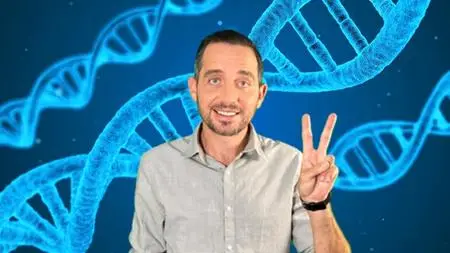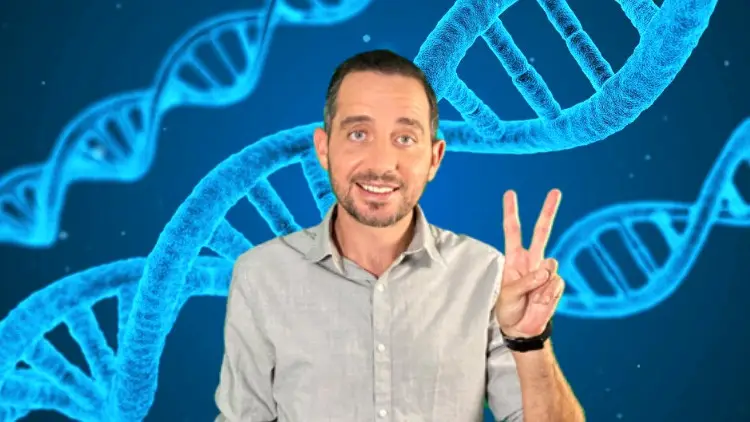Master the Fundamentals of Biology (Part 2 of 4) NEW
Last updated 11/2022
Duration: 1h55m | .MP4 1280x720, 30 fps(r) | AAC, 44100 Hz, 2ch | 1.69 GB
Genre: eLearning | Language: English
Last updated 11/2022
Duration: 1h55m | .MP4 1280x720, 30 fps(r) | AAC, 44100 Hz, 2ch | 1.69 GB
Genre: eLearning | Language: English
This is a Biology Course for Students Preparing for Any High School Biology Exams (iGCSE, GCSE, AP Biology & More)
What you'll learn
In this course students will learn exactly what they need to know for their biology exams. Students will learn about:
Understand that the genome is the entire DNA of an organism and that a gene is a section of a molecule of DNA that codes for a specific protein
Understand that the nucleus of a cell contains chromosomes on which genes are located
Describe a DNA molecule as two strands coiled to form a double helix, the strands being linked by a series of paired bases: adenine (A) with thymine (T), and cy
Understand that an RNA molecule is single stranded and contains uracil (U) instead of thymine (T)
Describe the stages of protein synthesis including transcription and translation, including the role of mRNA, ribosomes, tRNA, codons and anticodons
Understand how genes exist in alternative forms called alleles which give rise to differences in inherited characteristics
Understand the meaning of the terms: dominant, recessive, homozygous, heterozygous, phenotype, and genotype
Understand the meaning of the term codominance
Understand that most phenotypic features are the result of polygenic inheritance rather than single genes
Describe patterns of monohybrid inheritance using a genetic diagram
Understand how to interpret family pedigrees
Predict probabilities of outcomes from monohybrid crosses
Understand how the sex of a person is controlled by one pair of chromosomes, XX in a female and XY in a male
Describe the determination of the sex of offspring at fertilisation, using a genetic diagram
Understand how division of a diploid cell by mitosis produces two cells that contain identical sets of chromosomes
Understand that mitosis occurs during growth, repair, cloning and asexual reproduction
Understand how division of a cell by meiosis produces four cells, each with half the number of chromosomes, and that this results in the formation of geneticall
Understand how random fertilisation produces genetic variation of offspring
Know that in human cells the diploid number of chromosomes is 46 and the haploid number is 23
Understand that variation within a species can be genetic, environmental, or a combination of both
Understand that mutation is a rare, random change in genetic material that can be inherited
Understand how a change in DNA can affect the phenotype by altering the sequence of amino acids in a protein
Understand how most genetic mutations have no effect on the phenotype, some have a small effect and rarely do they have a significant effect
Understand that the incidence of mutations can be increased by exposure to ionising radiation (for example, gamma rays, x-rays and ultraviolet rays) and some ch
Explain Darwin’s theory of evolution by natural selection
Understand how resistance to antibiotics can increase in bacterial populations, and appreciate how such an increase can lead to infections being difficult to co
Understand the differences between sexual and asexual reproduction
Understand that fertilisation involves the fusion of a male and female gamete to produce a zygote that undergoes cell division and develops into an embryo
Describe the structures of an insect-pollinated and a wind-pollinated flower and explain how each is adapted for pollination
Understand that the growth of the pollen tube followed by fertilisation leads to seed and fruit formation
Understand how germinating seeds utilise food reserves until the seedling can carry out photosynthesis
Understand that plants can reproduce asexually by natural methods (illustrated by runners) and by artificial methods (illustrated by cuttings)
Understand how the structure of the male and female reproductive systems are adapted for their functions
Understand the roles of oestrogen and progesterone in the menstrual cycle
Understand the roles of FSH and LH in the menstrual cycle
Describe the role of the placenta in the nutrition of the developing embryo
Understand how the developing embryo is protected by amniotic fluid
Understand the roles of oestrogen and testosterone in the development of secondary sexual characteristics
Requirements
This course has no prerequisites.
From beginner students to top students, you will be taught everything you need to know.
Description
If you or your child are preparing for your Biology exams and want to ensure you achieve top scores, this is the course for you! Designed specifically for international school students, home schoolers, and independent candidates studying
IGCSE Biology, GCSE Biology, Grade 9 & 10 Biology or Year 10 & 11 Biology
, this course will provide you with everything you need to know to revise efficiently and effectively.
This comprehensive course covers all the key topics of IGCSE Biology, from the structure and function of living organisms to the physiology of plants and animals. You'll learn about the major systems and processes of the body, including digestion, respiration, and circulation, as well as genetics, evolution, and ecology. Our expert instructor will guide you through each topic, providing you with clear explanations, examples, and visual aids to help you understand and remember what you've learned.
With this course, you'll be able to:
Review the entire IGCSE Biology syllabus
in a structured and focused manner.
Gain a deep understanding of each topic through
clear and concise explanations.
Reinforce your knowledge with
interactive quizzes and exercises
.
Stay motivated and on track with
helpful tips and strategies for success.
Get
instant feedback on your progress
and identify areas you need to work on.
This course includes:
Video lessons covering all the key topics of IGCSE Biology.
Quizzes and exercises to reinforce your understanding.
Downloadable revision notes and a comprehensive course syllabus.
Access to our expert instructors for support and guidance.
A supportive community of like-minded students to share your journey with.
Don't waste another minute feeling overwhelmed and unsure about your IGCSE Biology exams. Invest in your future and enrol in this high-impact revision course today! With our expert guidance, comprehensive coverage, and effective revision strategies, you'll be well on your way to achieving top scores and reaching your full potential.
Enroll now and take the first step towards success in your IGCSE Biology exams!
This course has two objectives:
To teach all aspects of IGCSE biology & GCSE biology theory: Content is delivered during quick, efficient video lessons that are easy to for students to understand and absorb.
To teach IGCSE biology & GCSE biology exam strategy: Exam strategy is one of the most important skills needed in the IGCSE exams. During this masterclass you will learn everything you need to know using full Past Exam Paper Walkthroughs.
Do you or your child need help learning high school biology like IGCSE biology, GCSE Biology or AP Biology from home? This course will give them the skills they need to feel confident for their exams.
This IGCSE biology (O Level) masterclass is offered by LearnFire on Udemy. This masterclass covers all the content needed to write the IGCSE and GCSE biology exams offered by
Pearson Edexcel (double or triple)
or
Cambridge CIE (core or extended)
or other exam boards like
Oxford AQA
.
Who this course is for:
Secondary School Or High School Students Currently Studying IGCSE Biology or GCSE Biology (O Levels)
Students Preparing To Take A-Level Or IB Diploma Program Biology
Home School or Self-Learning Students Learning Key Stage 4 (O Level) Biology
Biology Teachers Looking To brush Up On Their Biology Knowledge
Anyone Interested In Biology
More Info



